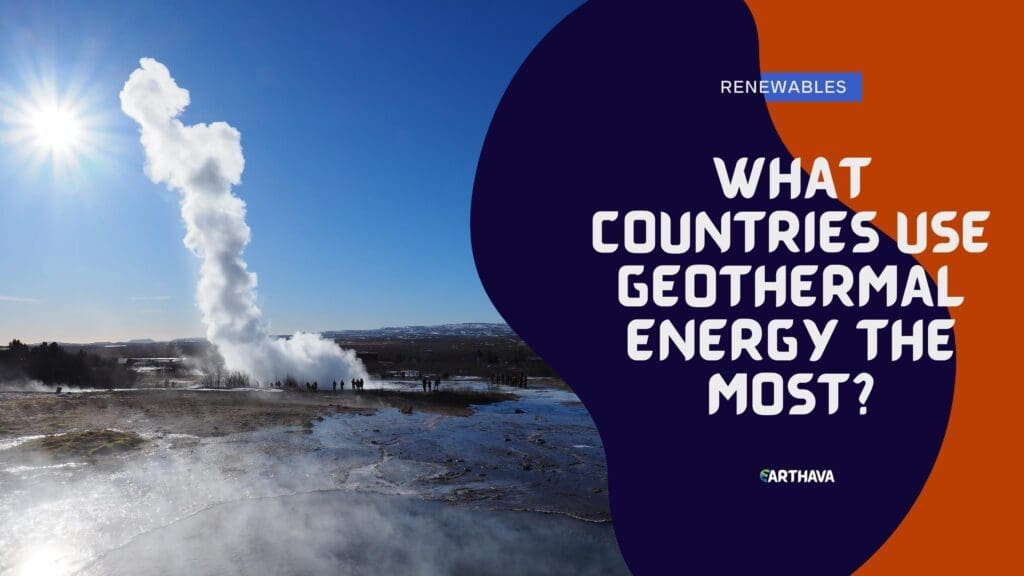Earth’s inner core is incredibly hot, and therefore releases a certain amount of heat — and this heat can be collected and converted into an energy resource called geothermal energy, which is clean, safe, and renewable. The process of collecting geothermal energy is pretty straightforward: It consists of placing pipes or digging wells underground in hot water or steam reservoirs and using the heat to fuel an electric generator that produces energy.

Related: How Does Geothermal Energy Work?
Geothermal energy is measured in megawatts (MW) and is considered renewable. This resource can be considered unlimited because Earth’s core doesn’t cool or have an expiration date. Its energy is mainly used to heat and cool buildings and produce electricity.
Who Are the Top Countries Harnessing Geothermal Energy?
Ranking a country’s use of energy can vary, mainly because a country can be ranked per capita or on installed capacity. For the sake of this article, countries are ranked based on installed capacity. Here are the top-producing countries of geothermal energy:
- The United States
- The Philippines
- Indonesia
- Turkey
- New Zealand
- Mexico
- Italy
- Iceland
- Kenya
- Japan
The United States ranks the highest on the list and certainly has a fair amount of plants, particularly in California, which ranks highest as the state that produces the most geothermal energy, producing 72% of the United States’ geothermal energy. It’s then followed by North Carolina, Arizona, Nevada, and New Jersey.
It may not be obvious, but all of these states have something in common: They are all western states, most of them located in the Pacific Northwest. This is because geothermal reservoirs such as geysers and hot springs are primarily located within this region of the United States. If you’ve ever paid a visit to Yellowstone National Park in Wyoming, you’ll understand how powerful these geysers and natural hot springs can be!
How They Are Harnessing It
Geothermal energy can be harnessed in one of two ways: extracted using a power plant or by means of a heat pump.
● Power Plants
When a power plant is at work, wells are dug into the ground that pump the hot water out. High pressure is applied to the water, and it turns into steam, which then turns into a generator that produces electricity that can power homes and businesses.
● Heat Pumps
When using the heat pump method, pipes placed underground pump water or a refrigerant that is heated below ground level, a process also known to heat swimming pools and buildings. It can also be reversed, meaning that these pipes can also cool buildings in the summertime as well.
Sustainability and Geothermal Energy
The current business model in the United States is: make, use, throw away. This is what is commonly referred to as a linear economy, and it’s what it sounds like It moves in one direction rather than a cyclical one. A linear model means something only travels one way; in the case of materials, it means they are ultimately thrown away and that it’s a nonrenewable practice.
The cyclical model is a sustainable one. It’s the inspiration for the recycle logo, with three arrows pointing to each other’s tails in a circle. It means that which is made can be used, and then used again. Commonly referred to as the circular economy, as demonstrated in this infographic, this form of sustainable economic model seeks to answer the question of how to live and work more sustainably.
According to the New Jersey Institute of Technology’s infographic, 9 billion people are projected to inhabit the earth by 2050 — that’s nearly 1.5 more billion people than we have today. To sustain comfortable, healthy living for future generations, people must come to terms with fostering more sustainable lifestyles.
History of Sustainability
Sustainable practices are somewhat new to the world. Here’s a brief overview of the history of sustainability:
- 1970: The first year for both Earth Day and the Clean Air Act
- 1972: The first plastic recycling plant in the U.S. Opens
- 2016: The Paris Agreement aiming to combat rising greenhouse gas emissions was signed into effect
Sustainable practices are key to a prosperous and healthy future. Harnessing sustainable resources such as geothermal energy makes for a healthier today and tomorrow.


